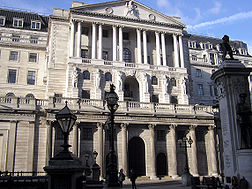
Bank of England Museum
Encyclopedia

Bank of England
The Bank of England is the central bank of the United Kingdom and the model on which most modern central banks have been based. Established in 1694, it is the second oldest central bank in the world...
, London
City of London
The City of London is a small area within Greater London, England. It is the historic core of London around which the modern conurbation grew and has held city status since time immemorial. The City’s boundaries have remained almost unchanged since the Middle Ages, and it is now only a tiny part of...
, England
England
England is a country that is part of the United Kingdom. It shares land borders with Scotland to the north and Wales to the west; the Irish Sea is to the north west, the Celtic Sea to the south west, with the North Sea to the east and the English Channel to the south separating it from continental...
in Bartholomew Lane.
The museum is open to the public, free of charge, on weekdays only and on the day of the Lord Mayor's Show.
It covers around 10,000 square feet (1,000 square metres), and includes a reconstruction of a late 18th century office. Known as The Stock Office, this is where holders of Bank stock would come to collect their dividends. Displays in this area cover the history of the bank in roughly chronological order, including many images showing the rebuilding of the Bank in the inter-war years, and several figures in appropriate attire. Another section, called The Bank Today, uses modern technology to bring the Bank's current activities to a wider audience.
Other displays of examples from the Bank's collections of banknote
Banknote
A banknote is a kind of negotiable instrument, a promissory note made by a bank payable to the bearer on demand, used as money, and in many jurisdictions is legal tender. In addition to coins, banknotes make up the cash or bearer forms of all modern fiat money...
s and coins
COinS
ContextObjects in Spans, commonly abbreviated COinS, is a method to embed bibliographic metadata in the HTML code of web pages. This allows bibliographic software to publish machine-readable bibliographic items and client reference management software to retrieve bibliographic metadata. The...
, book
Book
A book is a set or collection of written, printed, illustrated, or blank sheets, made of hot lava, paper, parchment, or other materials, usually fastened together to hinge at one side. A single sheet within a book is called a leaf or leaflet, and each side of a leaf is called a page...
s and documents, pictures, furniture
Furniture
Furniture is the mass noun for the movable objects intended to support various human activities such as seating and sleeping in beds, to hold objects at a convenient height for work using horizontal surfaces above the ground, or to store things...
, statue
Statue
A statue is a sculpture in the round representing a person or persons, an animal, an idea or an event, normally full-length, as opposed to a bust, and at least close to life-size, or larger...
s, silver
Silver
Silver is a metallic chemical element with the chemical symbol Ag and atomic number 47. A soft, white, lustrous transition metal, it has the highest electrical conductivity of any element and the highest thermal conductivity of any metal...
and even a real gold
Gold
Gold is a chemical element with the symbol Au and an atomic number of 79. Gold is a dense, soft, shiny, malleable and ductile metal. Pure gold has a bright yellow color and luster traditionally considered attractive, which it maintains without oxidizing in air or water. Chemically, gold is a...
bar
Gold bar
A gold bar is a quantity of refined metallic gold of any shape that is made by a bar producer meeting standard conditions of manufacture, labeling, and record keeping....
that can be handled can be found in the Rotunda area.
Previously access to the Bank's collections had been by appointment only and visitors were escorted through the Bank to a small display area. In the 1980s the Bank decided that it would like to make its collections (and indeed itself) available to a greater audience and so planned to create a new museum which would open in 1994 the year of the Bank's tercentenary.
However a fire in 1986 caused severe damage to the area of the Bank above the proposed site and it was decided to begin work then rather than repair and rebuild later. The work took about 18 months to complete and the new museum, designed by exhibition consultants Higgins Gardner & Partners, was opened in 1988 by the Queen. In the same year it received the City Heritage Award and the Stone Federation Award for Outstanding Craftsmanship.
Displays
Kenneth GrahameKenneth Grahame
Kenneth Grahame was a Scottish writer, most famous for The Wind in the Willows , one of the classics of children's literature. He also wrote The Reluctant Dragon; both books were later adapted into Disney films....
, the author of The Wind in the Willows
The Wind in the Willows
The Wind in the Willows is a classic of children's literature by Kenneth Grahame, first published in 1908. Alternately slow moving and fast paced, it focuses on four anthropomorphised animal characters in a pastoral version of England...
worked for thirty years at the bank rising to the rank of Secretary, and the museum has a permanent display which includes his dramatic resignation letter.

